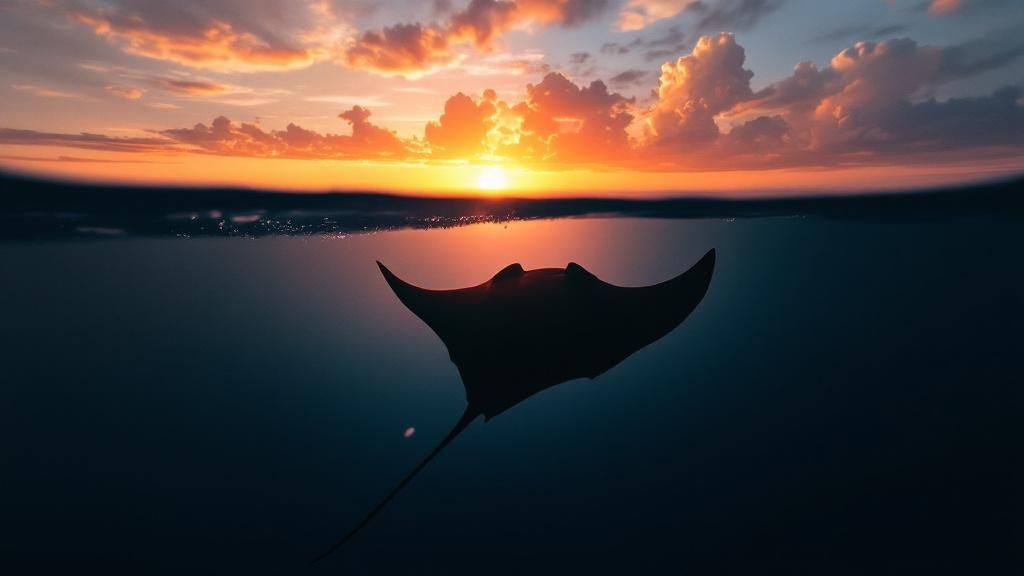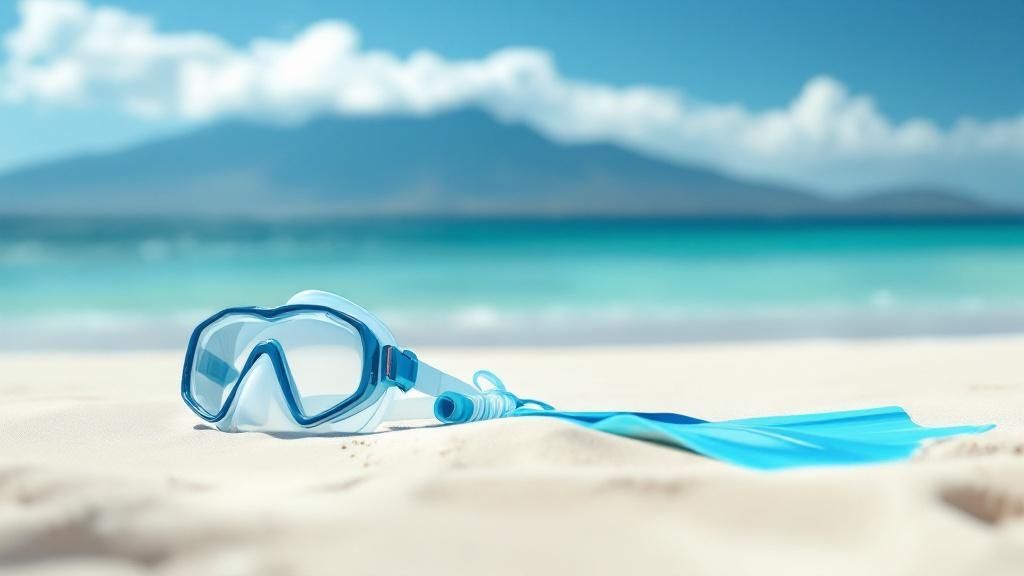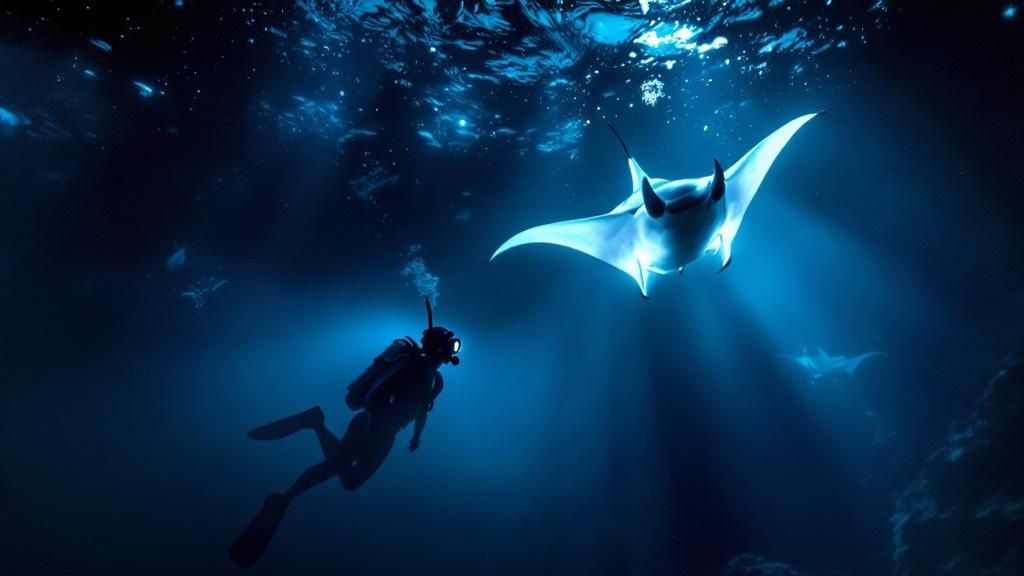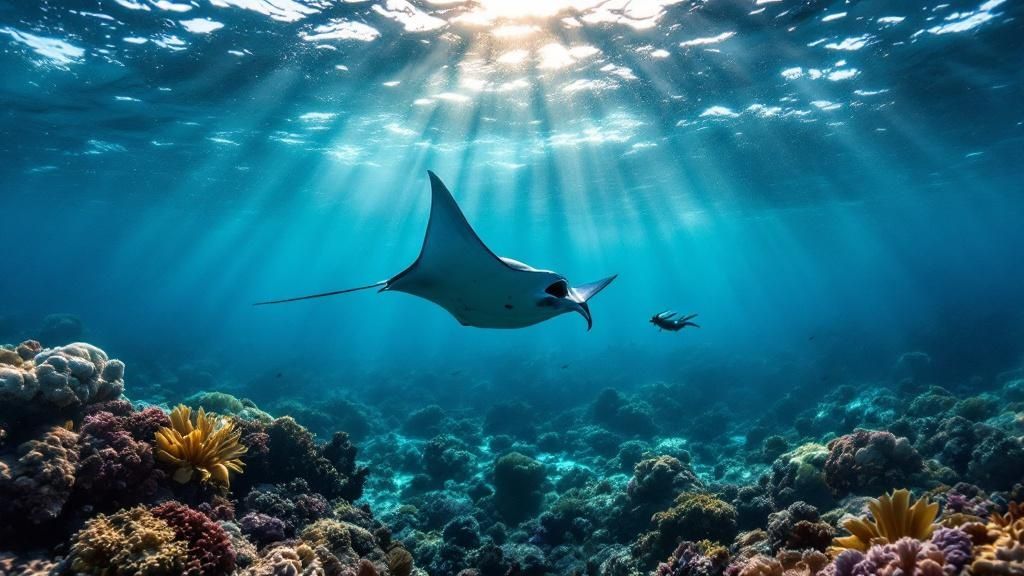Manta Ray Snorkel Big Island Adventure Guide
- Byron
- Jul 18
- 10 min read
Picture this: you're floating in the warm, dark Pacific waters off the Big Island. Suddenly, a majestic creature with a wingspan wider than a car glides effortlessly just inches beneath you, illuminated by underwater lights. This isn't a scene from a movie—it's the very real magic of the manta ray night snorkel, one of Hawaii's most unforgettable adventures.
If this incredible encounter is on your bucket list, you've come to the right place. This guide will cover everything you need to know to make it happen. Learn more about the manta ray night snorkel at Manta Ray Night Snorkel Hawaii.
Your Unforgettable Night with Gentle Giants
This is so much more than a typical snorkeling trip. It’s an up-close and personal experience with some of the ocean's most graceful animals, a true underwater ballet. But don't just take our word for it. Hearing from people who've already done it, like the guests of Manta Ray Night Snorkel Hawaii, shows just how special this tour is.

Why This Encounter Is So Special
So, what makes the Kona Coast of Hawaii's Big Island the world's premier spot for swimming with manta rays? It really comes down to the numbers. The area is home to a healthy, resident population of over 450 identified mantas. This incredible density of animals means that sightings aren't just a lucky break—they're practically guaranteed.
Famous viewing areas like "Manta Village" and "Manta Heaven" have become legendary for their reliability.
Tour operators in these spots report an astounding 85-90% success rate for manta ray sightings. On an average night, you can expect to see about three of these gentle giants. You can dig into more of these amazing manta ray statistics on konahonudivers.com.
This high chance of seeing the mantas, combined with their calm nature and the expertise of local tour operators, creates a safe and truly magical experience for everyone, from first-time snorkelers to seasoned divers.
Here’s a glimpse of what we'll cover to get you ready for your own adventure:
Why Kona is the undisputed world capital for manta ray encounters.
What to expect on a typical tour, from start to finish.
Essential tips to help you prepare for your trip.
Some fascinating biology behind these incredible animals.
Why Kona Is the World Capital for Manta Rays

What makes the Kona coast of the Big Island the single most reliable place on Earth to see manta rays? It's not just a lucky accident. It’s the perfect storm of unique geography, ideal ocean conditions, and a little bit of human history all coming together. This special combination has made Kona a year-round gathering spot for these incredible animals. It’s an experience that truly sticks with you, as the glowing reviews for Manta Ray Night Snorkel Hawaii constantly show.
At its heart, the secret is all about the food. Manta rays are filter feeders, dining on clouds of microscopic zooplankton. The volcanic underwater terrain along the Kona coast happens to be the perfect environment for these tiny organisms to flourish. In short, it’s a natural, all-you-can-eat buffet that keeps the mantas coming back night after night.
The Plankton Buffet Phenomenon
The whole thing started by chance decades ago when a hotel aimed bright lights into the ocean. These lights attracted huge swarms of plankton, which then caught the attention of the local manta rays. It didn't take long for tour operators to see what was happening. They began to recreate this effect with their own powerful, eco-friendly lights, essentially setting the dinner table for the mantas.
Think of it like a popular food truck that parks in the same spot every evening. The mantas are smart. They quickly learned that these specific spots meant a guaranteed meal. This learned behavior is precisely why the manta ray snorkel Big Island experience has become so incredibly dependable.
Two world-famous viewing sites have become the go-to locations for this nightly show:
Manta Village: This is the original site, just south of Kailua-Kona. It’s well-known for its calm waters and consistently high number of manta sightings.
Manta Heaven: Located north of Kona near the airport, this spot is another major feeding ground that often draws in large groups of mantas.
A Gentle and Predictable Giant
A lot of marine wildlife tours depend on catching animals during seasonal migrations, which can be hit or miss. But the reef mantas in Kona are different. They're a resident population, meaning they live here all year long. This is why you have a fantastic chance of seeing them no matter when you visit.
The Hawaiian name for the manta ray is **hāhālua**, which can be interpreted to mean "two breaths." The name itself hints at their deep cultural importance and connection to the islands.
This predictability is what makes the Kona encounter so unique. You aren't just hoping to spot an animal passing through; you're visiting a place they call home. It’s this deep respect for the local ecosystem that makes such a magical and unforgettable experience possible.
What to Expect on Your Manta Ray Snorkel Tour
Knowing what’s coming on your manta ray snorkel Big Island tour can turn any pre-trip jitters into pure excitement. When you understand the flow of the evening, you can just relax and soak it all in. So, let’s walk through a typical tour, from the moment you leave the harbor to the unforgettable underwater ballet.
Your adventure starts at a local harbor, where you’ll meet your crew. The boat ride to the snorkel site is an experience in itself. Depending on when you go, you might be treated to a classic Kona sunset painting the sky, or you could even see a pod of spinner dolphins playing in the boat's wake. It’s the perfect start to the evening.

Getting Briefed and Geared Up
Once you’re cruising, the lifeguard-certified guides will give you a full safety briefing. They'll go over everything from how to properly use your snorkel gear to the most important rule for interacting with the mantas: passive observation. In other words, look but don't touch!
This is also when you'll get fitted for your gear, including a mask, snorkel, and usually a wetsuit top to keep you warm. The star of the show, equipment-wise, is the light board.
This isn't just any old floatie. It’s a custom-designed flotation raft with powerful, eco-friendly lights aimed down into the ocean. You just hang onto the handrails, making it easy and accessible even if you're not a strong swimmer.
These lights are brilliant. Not only do they give you something stable to hold onto, but they attract the plankton that manta rays absolutely love to eat. This simple setup is what makes the whole encounter possible. For an even more detailed rundown, check out our [complete adventure guide to the Kona manta ray snorkel](https://www.mantaraynightsnorkelhawaii.com/post/manta-ray-snorkel-kona-your-complete-adventure-guide).
The Main Event: An Underwater Ballet
When you arrive at the viewing site, you’ll slip into the dark water and find a spot at the light board. Floating on the surface and looking down through your mask, you'll see the light beams create a beautifully illuminated stage below. And then, the magic begins.
One by one, the giant manta rays appear. With wingspans reaching up to 12 feet or more, they glide into the light with incredible grace. You'll watch them perform a mesmerizing underwater ballet, barrel-rolling and swooping just inches beneath you to feed on the plankton. It's a peaceful, awe-inspiring spectacle, and you’re right there to witness it.
After about 45 minutes of pure wonder in the water, you’ll climb back onto the boat, buzzing with what you just saw.
How to Prepare for a Great Manta Experience
A little preparation can make the difference between a good manta ray tour and an unforgettable one. Knowing what to expect and what to pack means you can relax and focus on the incredible experience without worrying about the small stuff.

The practical stuff is pretty straightforward. Show up with your swimsuit already on under your clothes—it just makes everything easier. You'll definitely want a warm towel and a dry jacket or change of clothes for the boat ride back, as the night air can get chilly. Thinking about it like packing for any other water activity helps; many of the essential items for a day at the beach apply here, too.
The Golden Rule: Passive Observation
If there’s one thing to remember, it’s this: passive observation. This is the most important rule of any wildlife encounter, and it absolutely applies here. You should never, ever try to touch a manta ray.
Mantas have a protective mucus layer covering their skin. Think of it as their immune system. Touching them can rub this layer off, leaving them exposed to harmful bacteria and infections.
Your guides will go over this, but it’s worth repeating. Just float, watch, and let them do their thing. It’s the best way to respect these gentle giants and ensure they stick around for years to come.
Tips for First-Time or Nervous Snorkelers
Feeling a little nervous about getting in the ocean at night? That’s completely normal. The good news is these tours are designed to be safe and comfortable for just about everyone, even if you're not a strong swimmer. The custom light boards you hold onto are incredibly buoyant, so all you have to do is hang on and watch the show below.
A few things that might help ease your mind:
Trust the Gear: The flotation boards do all the work, keeping you stable on the surface. Most operators also provide wetsuit tops, which add a bit of extra warmth and buoyancy.
Listen to Your Guides: The crew members are experts at this. They're typically lifeguard-certified and know how to make everyone feel safe and at ease in the water.
Just Breathe: Once you get in the water and put your face down, take a few slow, deep breaths through your snorkel. The moment you see the mantas, everything else tends to melt away.
With these simple tips in mind, you’re all set for a truly amazing adventure.
Getting to Know Kona's Manta Rays
Your tour is going to be so much more rewarding once you know a little about the incredible animals you're about to meet. Learning about Kona’s reef manta rays turns a fun swim into a real connection with one of the ocean's most majestic creatures. These aren't just big, graceful fish; they're smart, social animals with some truly mind-blowing behaviors.
You'll see them doing what looks like an underwater ballet—effortless barrel rolls through clouds of plankton. With their mouths wide open, they glide and filter their food in a way that’s both beautiful and incredibly efficient.
A Fingerprint on Their Belly
So, how do we know so much about the local manta population? It’s all thanks to their bellies. Each manta ray has a unique pattern of black spots on its underside, just like a human fingerprint.
This allows researchers and guides to identify individual mantas year after year. They even give them names! Knowing you might be swimming with a specific, named manta adds a personal touch to your manta ray snorkel Big Island experience.
Understanding their life story gives you a much deeper appreciation for their role in the marine ecosystem. You can dive deeper into this in our [ultimate guide for unforgettable manta ray encounters](https://www.mantaraynightsnorkelhawaii.com/post/manta-ray-snorkel-big-island-ultimate-guide-for-unforgettable-encounters).
Far-Reaching Travelers of the Coast
For a long time, we thought Kona's mantas stayed within a relatively small area of about 90 square miles. But between 2009 and 2014, researchers watched them almost every night, tracking their movements up and down the coast. The results were surprising.
It turns out some individual mantas travel between locations as far as 55 miles apart! This discovery completely changed our understanding of their range, showing just how dynamic their lives really are. You can learn more about these manta ray findings on mantarayadvocates.com.
Knowing these little details transforms your trip from a simple tour into a genuine appreciation for these gentle giants of the sea.
Frequently Asked Questions About Manta Snorkeling
As you get ready to book your manta ray snorkel Big Island tour, a few last-minute questions usually pop up. It’s completely normal! We've put together answers to the most common things people ask, so you can feel totally prepared for this amazing adventure.
You're about to experience something our guests consistently call the highlight of their entire trip. The team here at Manta Ray Night Snorkel Hawaii is obsessed with getting it right, so let's clear up those final details for you.
Is the Manta Ray Night Snorkel Safe?
Yes, absolutely. Safety is the number one priority for every reputable tour operator out here, and it's a question we get all the time. You won’t be swimming around freely in the open ocean after dark. Instead, you'll be holding onto a large, stable flotation board custom-built for this experience.
Before you even dip a toe in the water, lifeguard-certified guides run through a thorough safety briefing. It also helps to remember that manta rays are truly gentle giants. They have no teeth, no stingers, and no barbs. They are only interested in the plankton drawn to the lights, not the people watching them.
What Is the Best Time of Year to See Manta Rays?
This is one of the best things about manta ray snorkeling in Kona: you can see them year-round. The local manta population lives here full-time and doesn’t migrate, which is fantastic for visitors.
Sighting rates stay consistently high whether you visit in July or December. You can book your manta ray snorkel Big Island tour for any season with confidence, knowing the mantas are almost certain to be there to greet you.
Do I Need to Be a Strong Swimmer for This Tour?
Not at all. This tour was designed from the ground up to be accessible for everyone, even non-swimmers. You do very little actual swimming.
For the entire time you're in the ocean, you'll be holding onto a big, super-buoyant light board. It does all the work, letting you float comfortably on the surface while you watch the incredible ballet below. If you can float in a pool, you can do this.
The light board is the secret sauce. It’s your secure handrail, your viewing platform, and the light source all in one, making the experience both safe and spectacular for every single person.
Will I Get Cold During a Night Snorkel?
While Kona's ocean water is pretty warm, it’s normal to get a little chilly after floating for a while at night. To keep you comfortable, good tour companies will provide wetsuit tops.
Our advice? Definitely wear the one they offer you. It makes a huge difference in staying warm and adds a little extra buoyancy. It's also smart to bring your own warm towel and a jacket or hoodie for the boat ride back to the harbor.
For even more tips and a deeper look into what makes this tour so special, check out our [ultimate guide to Hawaii's most magical tour](https://www.mantaraynightsnorkelhawaii.com/post/manta-ray-snorkel-kona-the-ultimate-guide-to-hawaii-s-most). Booking with a trusted crew ensures you’ll have everything you need for a comfortable and unforgettable night.
Comments